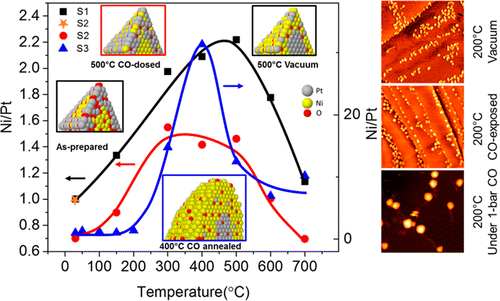Our official English website, www.x-mol.net, welcomes your
feedback! (Note: you will need to create a separate account there.)
Carbon Monoxide-Induced Stability and Atomic Segregation Phenomena in Shape-Selected Octahedral PtNi Nanoparticles
ACS Nano ( IF 15.8 ) Pub Date : 2015-10-08 00:00:00 , DOI: 10.1021/acsnano.5b01807
Mahdi Ahmadi 1 , Chunhua Cui 2 , Hemma Mistry 1, 3 , Peter Strasser 2 , Beatriz Roldan Cuenya 3
ACS Nano ( IF 15.8 ) Pub Date : 2015-10-08 00:00:00 , DOI: 10.1021/acsnano.5b01807
Mahdi Ahmadi 1 , Chunhua Cui 2 , Hemma Mistry 1, 3 , Peter Strasser 2 , Beatriz Roldan Cuenya 3
Affiliation

|
The chemical and morphological stability of size- and shape-selected octahedral PtNi nanoparticles (NP) were investigated after different annealing treatments up to a maximum temperature of 700 °C in a vacuum and under 1 bar of CO. Atomic force microscopy was used to examine the mobility of the NPs and their stability against coarsening, and X-ray photoelectron spectroscopy to study the surface composition, chemical state of Pt and Ni in the NPs, and thermally and CO-induced atomic segregation trends. Exposing the samples to 1 bar of CO at room temperature before annealing in a vacuum was found to be effective at enhancing the stability of the NPs against coarsening. In contrast, significant coarsening was observed when the sample was annealed in 1 bar of CO, most likely as a result of Ni(CO)4 formation and their enhanced mobility on the support surface. Sample exposure to CO at room temperature prior to annealing led to the segregation of Pt to the NP surface. Nevertheless, oxidic PtOx and NiOx species still remained at the NP surface, and, irrespective of the initial sample pretreatment, Ni surface segregation was observed upon annealing in a vacuum at moderate temperature (T < 300 °C). Interestingly, a distinct atomic segregation trend was detected between 300 and 500 °C for the sample pre-exposed to CO; namely, Ni surface segregation was partially hindered. This might be attributed to the higher bonding energy of CO to Pt as compared to Ni. Annealing in the presence of 1 bar CO also resulted in the initial surface segregation of Ni (T < 400 °C) as long as PtOx and NiOx species were available on the surface as a result of the higher affinity of Ni for oxygen. Above 500 °C, and regardless of the sample pretreatment, the diffusion of Pt atoms to the NP surface and the formation of a Ni–Pt alloy are observed.
中文翻译:

形状选择的八面体PtNi纳米颗粒中的一氧化碳诱导的稳定性和原子偏析现象。
在不同的退火处理条件下,在真空和1 bar CO下最高温度达到700°C后,研究了尺寸和形状选择的八面体PtNi纳米粒子(NP)的化学和形态稳定性。使用原子力显微镜检查NP的迁移率及其对粗化的稳定性,并通过X射线光电子能谱研究NP的表面组成,Pt和Ni的化学状态以及热和CO诱导的原子偏析趋势。发现在真空中退火之前将样品在室温下暴露于1 bar的CO可有效提高NP抵抗粗化的稳定性。相反,当样品在1 bar CO中退火时,观察到明显的粗化,这很可能是Ni(CO)4的结果。的形成及其在支撑表面上的流动性增强。在退火之前,样品在室温下暴露于CO会导致Pt分离到NP表面。尽管如此,氧化的PtO x和NiO x种类仍然保留在NP表面,并且与初始样品预处理无关,在中等温度(T <300°C)的真空下退火时,观察到Ni表面偏析。有趣的是,对于预先暴露于CO的样品,在300至500°C之间检测到明显的原子偏析趋势。即,部分阻碍了Ni的表面偏析。这可能归因于与Ni相比,CO与Pt的键能更高。在1 bar CO的存在下进行退火还会导致Ni(由于Ni对氧气的亲和力更高,因此只要PtO x和NiO x种类在表面上可用,T <400°C)。在高于500°C的温度下,无论样品经过何种预处理,都会观察到Pt原子向NP表面的扩散以及Ni-Pt合金的形成。
更新日期:2015-10-08
中文翻译:

形状选择的八面体PtNi纳米颗粒中的一氧化碳诱导的稳定性和原子偏析现象。
在不同的退火处理条件下,在真空和1 bar CO下最高温度达到700°C后,研究了尺寸和形状选择的八面体PtNi纳米粒子(NP)的化学和形态稳定性。使用原子力显微镜检查NP的迁移率及其对粗化的稳定性,并通过X射线光电子能谱研究NP的表面组成,Pt和Ni的化学状态以及热和CO诱导的原子偏析趋势。发现在真空中退火之前将样品在室温下暴露于1 bar的CO可有效提高NP抵抗粗化的稳定性。相反,当样品在1 bar CO中退火时,观察到明显的粗化,这很可能是Ni(CO)4的结果。的形成及其在支撑表面上的流动性增强。在退火之前,样品在室温下暴露于CO会导致Pt分离到NP表面。尽管如此,氧化的PtO x和NiO x种类仍然保留在NP表面,并且与初始样品预处理无关,在中等温度(T <300°C)的真空下退火时,观察到Ni表面偏析。有趣的是,对于预先暴露于CO的样品,在300至500°C之间检测到明显的原子偏析趋势。即,部分阻碍了Ni的表面偏析。这可能归因于与Ni相比,CO与Pt的键能更高。在1 bar CO的存在下进行退火还会导致Ni(由于Ni对氧气的亲和力更高,因此只要PtO x和NiO x种类在表面上可用,T <400°C)。在高于500°C的温度下,无论样品经过何种预处理,都会观察到Pt原子向NP表面的扩散以及Ni-Pt合金的形成。


































 京公网安备 11010802027423号
京公网安备 11010802027423号